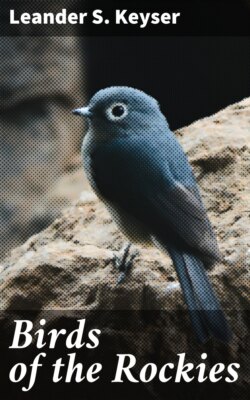Читать книгу Birds of the Rockies - Leander S. Keyser - Страница 7
На сайте Литреса книга снята с продажи.
INTRODUCTION TO SOME SPECIES
ОглавлениеTable of Contents
INTRODUCTION TO SOME SPECIES
It was night when I found lodgings in the picturesque village of Manitou, nestling at the foot of the lower mountains that form the portico to Pike's Peak. Early the next morning I was out for a stroll along the bush-fringed mountain brook which had babbled me a serenade all night. To my delight, the place was rife with birds, the first to greet me being robins, catbirds, summer warblers, and warbling vireos, all of which, being well known in the East, need no description, but are mentioned here only to show the reader that some avian species are common to both the East and the West.
But let me pause to pay a little tribute to the brave robin redbreast. Of course, here he is called the "western robin." His distribution is an interesting scientific fact. I found him everywhere—on the arid plains and mesas, in the solemn pines of the deep gulches and passes, and among the scraggy trees bordering on timber-line, over ten thousand feet above sea-level. In Colorado the robins are designated as "western," forms by the system-makers, but, even though called by a modified title, they deport themselves, build their nests, and sing their "cheerily, cheerily, cheer up," just as do their brothers and sisters of the land toward the rising sun. If there is any difference, their songs are not so loud and ringing, and their breasts not quite so ruddy as are those of the eastern types. Perhaps the incessant sunshine of Colorado bleaches out the tints somewhat.
But in my ante-breakfast stroll at Manitou I soon stumbled upon feathered strangers. What was this little square-shouldered bird that kept uttering a shrill scream, which he seemed to mistake for a song? It was the western wood-pewee. Instead of piping the sweet, pensive "Pe-e-e-o-we-e-e-e" of the woodland bird of the Eastern States, this western swain persists in ringing the changes hour by hour upon that piercing scream, which sounds more like a cry of anguish than a song. At Buena Vista, where these birds are superabundant, their morning concerts were positively painful. One thing must be said, however, in defence of the western wood-pewee—he means well.
Another acquaintance of my morning saunter was the debonair Arkansas goldfinch, which has received its bunglesome name, not from the State of Arkansas, but from the Arkansas River, dashing down from the mountains and flowing eastwardly through the southern part of Colorado. Most nattily this little bird wears his black cap, his olive-green frock, and his bright yellow vest. You will see at once that he dresses differently from the American goldfinch, so well known in the East, and, for that matter, just as well known on the plains of Colorado, where both species dwell in harmony. There are some white markings on the wings of Spinus psaltria that give them a gauze-like appearance when they are rapidly fluttered.
His song and some of his calls bear a close resemblance to those of the common goldfinch, but he is by no means a mere duplicate of that bird; he has an individuality of his own. While his flight is undulatory, the waviness is not so deeply and distinctly marked; nor does he sing a cheery cradle-song while swinging through the ether, although he often utters a series of unmusical chirps. One of the most pleasingly pensive sounds heard in my western rambles was the little coaxing call of this bird, whistled mostly by the female, I think. No doubt it is the tender love talk of a young wife or mother, which may account for its surpassing sweetness.
Every lover of feathered kind is interested in what may be called comparative ornithology, and therefore I wish to speak of another western form and its eastern prototype—Bullock's oriole, which in Colorado takes the place of the Baltimore oriole known east of the plains all the way to the Atlantic coast. However, Bullock's is not merely a variety or subspecies, but a well-defined species of the oriole family, his scientific title being Icterus bullocki.
Like our familiar Lord Baltimore, he bravely bears black and orange; but in bullocki the latter color invades the sides of the neck, head, and forehead, leaving only a small black bow for the throat and a narrow black stripe running back over the crown and down the back of the neck; whereas in Icterus galbula the entire head and neck are black. Brilliant as Bullock's oriole is, he does not seem to be anxious to display his fineries, for he usually makes it a point to keep himself ensconced behind a clump of foliage, so that, while you may hear a desultory piping in the trees, apparently inviting your confidence, it will be a long time before you can get more than a provoking glimpse of the jolly piper himself. "My gorgeous apparel was not made for parade," seems to be his modest disclaimer.
He is quite a vocalist. Here is a quotation from my lead-pencil, dashes and all: "Bullock's oriole—fine singer—voice stronger than orchard oriole's—song not quite so well articulated or so elaborate, but louder and more resonant—better singer than the Baltimore." It might be added that Bullock's, like the orchard, but unlike the Baltimore, pipes a real tune, with something of a theme running through its intermittent outbursts. The plumage of the young bird undergoes some curious changes, and what I took to be the year-old males seemed to be the most spirited musicians.
Maurice Thompson's tribute to the Baltimore oriole will apply to that bird's western kinsman. He calls him:—
